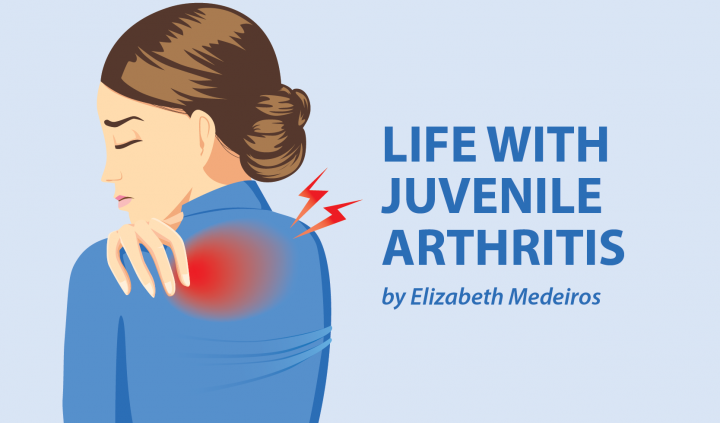My boyfriend and I were binge-watching “The Mandalorian” on a recent Sunday morning. I was so relaxed that I let out a big yawn. But as I opened my mouth, my jaw made a loud cracking sound. My boyfriend looked terrified and asked if anything was broken. I admit it did sound like something had snapped. But I was OK, the cracking sound was due to stiffness caused by arthritis in my jaw.
It’s common for kids with juvenile idiopathic arthritis (JIA) to have arthritis in their temporomandibular joint (TMJ), or jaw. Pediatric rheumatologists often check their patients’ jaws because symptoms can be silent or mild at first. I remember my doctor palpating my jaw long before I had issues, and I’m glad we caught my problems early.
TMJ flares
When I’ve mentioned my jaw issues to others, I appreciate that they sometimes share recipes for soft foods. But I wish that eating soup and ice cream was enough to take away the pain.
I’ve read that people with JIA who experience orofacial pain — pain in the mouth, face, and jaw — “have more stress, limitations on daily activities, disease activity, and systemic inflammation than those who do not.” I agree that a painful jaw can affect your life in ways many can’t imagine. Some of the most severe flares I’ve had were in my jaw.
In my experience, TMJ flares don’t just affect my mouth, they also make my entire upper body ache. My face will feel incredibly sore, as if I’ve been grinning all day, and my eyes will feel so tired that it’s hard to keep them open. I find it challenging to use the computer or read books because the postures aggravate my neck — which is also affected by JA — and shoulders. I feels as if my muscles are knotted and irritated. And my teeth often ache as if I have an infection, and this usually happens in the middle of the night. Not to mention the typical fatigue and soreness that come with a flare.
Treating a flare at home
Your child’s rheumatologist and dentist should create a plan to treat your child’s TMJ arthritis. Your child may need splints or braces as they grow. They may also need steroid injections if the inflammation is severe or prolonged.
Soft food diets and stretches are two essential things you can do at home to help a flare subside. Parents can help to treat their child’s jaw pain in other ways, including:
Soft bedding
Your child might need an extra soft pillow to sleep comfortably if their jaw is flaring. My favorite pillows are Squishmallow stuffed animals — they’re the only thing gentle enough to sleep on when my jaw or neck is bothering me.
If anything touching the side of their face seems painful, try using a travel pillow. I don’t recommend letting your child sleep with it around their neck. Instead, they might like to use it like a real pillow, with the hole aligned with the side of their face. I’ve found it very comforting to have my head supported without pressure on my jaw. You can achieve the same effect with rolled towels.
Sit up straight
Some postures can aggravate TMJ arthritis, such as looking down to text or read. Encouraging your child to get up to stretch can help to avoid the painful strain. A few minutes here and there can make a big difference.
Smaller, more frequent meals
During TMJ flares, eating can be both painful and tiring, and opening your mouth to take a bite can be exhausting. Kids may benefit from five or six small meals a day rather than three large ones.
Hot and cold therapy
Just like with any other arthritic joint, heat and cold packs can be helpful. It’s a little tricky to keep them on though. Having your child lie on their side is usually the best way to go about it, though the pressure might be too much for them.
Sticking to treatments
Like with other joints, sometimes your child’s jaw will be flaring, and at other times it’s not as troublesome. You never know what JA will bring each day, but we hope that tomorrow will be better.
I recommend finding a treatment that works and sticking with it. For example, I have a retainer that helps to keep my jaw in the correct position at night. Even though it helps my joints, I hate how it feels while I sleep. When I’m tempted to skip wearing it, I remind myself that all of the unpleasant aspects of taking care of my JA — retainers, shots, and gross pills — aren’t nearly as bad as the pain.
***
Note: Juvenile Arthritis News is strictly a news and information website about the disease. It does not provide medical advice, diagnosis, or treatment. This content is not intended to be a substitute for professional medical advice, diagnosis, or treatment. Always seek the advice of your physician or other qualified health provider with any questions you may have regarding a medical condition. Never disregard professional medical advice or delay in seeking it because of something you have read on this website. The opinions expressed in this column are not those of Juvenile Arthritis News, or its parent company, BioNews Services, and are intended to spark discussion about issues pertaining to juvenile arthritis.

